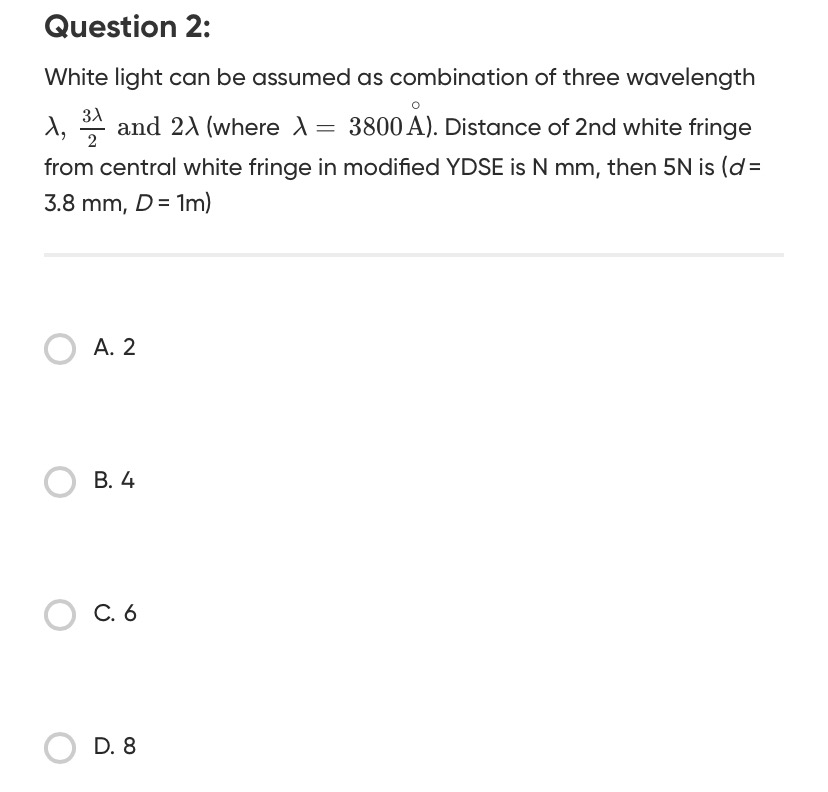Question
Question: White light can be assumed as combination of three wavelength $\lambda$, $\frac{3\lambda}{2}$ and $2...
White light can be assumed as combination of three wavelength λ, 23λ and 2λ (where λ=3800A∘). Distance of 2nd white fringe from central white fringe in modified YDSE is N mm, then 5N is (d=3.8 mm, D=1m)

2
4
6
8
6
Solution
In Young's Double Slit Experiment (YDSE), white light consists of various wavelengths. The central fringe is always white because all wavelengths interfere constructively at the center (path difference = 0). For subsequent white fringes, we need to find positions where constructive interference occurs for all the specified wavelengths simultaneously.
Let the three wavelengths be λ1=λ, λ2=23λ, and λ3=2λ. The position of the n-th order fringe for a wavelength λi is given by yi=dniλiD, where ni is an integer. For a white fringe to form at a position y, the path difference Δx=yDd must be an integer multiple of each of the given wavelengths. So, Δx=n1λ1=n2λ2=n3λ3, where n1,n2,n3 are integers.
Substituting the given wavelengths: Δx=n1λ=n2(23λ)=n3(2λ)
This implies that Δx must be a common multiple of λ, 23λ, and 2λ. The smallest non-zero common multiple corresponds to the first white fringe after the central one. We find the Least Common Multiple (LCM) of these wavelengths: LCM(λ,23λ,2λ) To find the LCM of fractions, we can write them with a common denominator: λ=22λ 23λ 2λ=24λ LCM(22λ,23λ,24λ)=GCD(2,2,2)LCM(2λ,3λ,4λ) LCM(2λ,3λ,4λ)=λ×LCM(2,3,4)=λ×12=12λ. GCD(2,2,2)=2. So, the smallest non-zero path difference for a white fringe is 212λ=6λ.
The path differences for consecutive white fringes are 0,6λ,12λ,18λ,…. The positions of these white fringes are given by ym=dm⋅6λD, where m=0,1,2,….
- Central white fringe (m=0): y0=0.
- 1st white fringe (m=1): y1=d6λD.
- 2nd white fringe (m=2): y2=d12λD.
The question asks for the distance of the 2nd white fringe from the central white fringe, which is y2. y2=d12λD
Given values: λ=3800A∘=3800×10−10 m d=3.8 mm =3.8×10−3 m D=1 m
Substitute these values into the expression for y2: y2=3.8×10−3 m12×(3800×10−10 m)×(1 m) y2=3.8×10−312×(3.8×103×10−10)×1 m y2=3.8×10−312×3.8×10−7 m y2=12×10−7×103 m y2=12×10−4 m
The distance is given as N mm. Convert y2 to millimeters: N mm=12×10−4 m×1 m1000 mm N=12×10−1 mm N=1.2 mm
The question asks for the value of 5N: 5N=5×1.2=6.0
